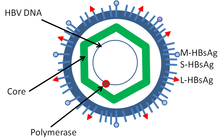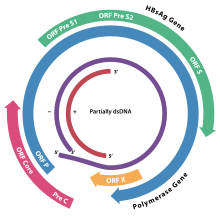HBcAg
| Capsid protein | |||||||
|---|---|---|---|---|---|---|---|
| Identifiers | |||||||
| Organism | |||||||
| Symbol | C | ||||||
UniProt | Q9QAB9 | ||||||
| |||||||
| Hepatitis core antigen | |||||||||
|---|---|---|---|---|---|---|---|---|---|
| Identifiers | |||||||||
| Symbol | Hepatitis_core | ||||||||
SCOP2 | 7abl / SCOPe / SUPFAM | ||||||||
| |||||||||


HBcAg (core antigen) is a hepatitis B viral protein.[1][2] It is an indicator of active viral replication; this means the person infected with Hepatitis B can likely transmit the virus on to another person (i.e. the person is infectious).
Structure and function
HBcAg is an
nucleocapsid core (the inner most layer of the hepatitis B virus). While both HBcAg and HBeAg are made from the same open reading frame, HBcAg is not secreted. HBcAg is considered "particulate" and it does not circulate in the blood but recent study show it can be detected in serum by Radioimmunoassay. However, it is readily detected in hepatocytes after biopsy. When both HBcAg and HBeAg proteins are present, it acts as a marker of viral replication
, and antibodies to these antigens indicates declining replication.
Interactions
T-lymphocyte response against HBV.[3]
